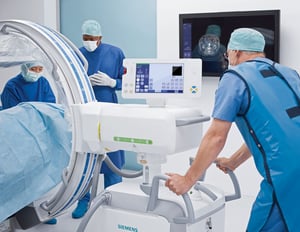 Many imaging facilities struggle with finding the backing necessary to make the types of purchases that can attract new patients, increase overall volume and positively affect reimbursement rates. Generally, the hardest-hit facilities tend to be:
Many imaging facilities struggle with finding the backing necessary to make the types of purchases that can attract new patients, increase overall volume and positively affect reimbursement rates. Generally, the hardest-hit facilities tend to be:
- Office-Based Labs
- Ambulatory Surgery Centers
- Critical Access Hospitals
Of course, larger hospitals certainly can have their own struggles with financing. When construction is cost-prohibitive, space is at a premium or the hospital board simply isn’t keen on giving the green light to a project, imaging managers and radiology directors may feel the need to put the brakes on important projects.
That’s unfortunate, as Medicare reimbursement and overall patient experience rely on the facility’s ability to keep up with advances in standard technology. In 2018, there were large changes for X-ray reimbursement, for example, with institutions that haven’t upgraded to digital X-ray seeing increased penalties for their lack of compliance. That makes funding even more crucial.
Financing challenges, however, aren’t insurmountable. In fact, we’ve worked with customers throughout the country to come up with creative, affordable solutions to secure imaging purchases that more than pay off their investment in the long run. These pave the way for additional enhancements and, most importantly, improve the patient experience.
Here, then, are some of the creative ways imaging professionals can establish a successful financing plan for their equipment purchase and/or construction project.
Capital Campaigns
This is one of the most common (and highly visible) ways to acquire financing for your imaging equipment.
By creating a capital campaign, you make your pitch directly to key donors, local financing partners, and your community at large. The allure of the capital campaign lies in being able to acquire the funding you need from outside sources, if not entirely, then at least for incremental portions of the outright purchase.
 This isn’t usually the standard route for smaller projects. The average capital campaign traffics in massive construction, either through the expansion or remodeling of an existing facility or the building of a new facility entirely. Typically, a capital campaign will have an entire branding effort behind it, complete with go-to-market strategies targeting key constituents who could potentially donate to the effort. There could be multiple fundraising events dedicated to the campaign.
This isn’t usually the standard route for smaller projects. The average capital campaign traffics in massive construction, either through the expansion or remodeling of an existing facility or the building of a new facility entirely. Typically, a capital campaign will have an entire branding effort behind it, complete with go-to-market strategies targeting key constituents who could potentially donate to the effort. There could be multiple fundraising events dedicated to the campaign.
If you have the resources to craft a capital campaign, then by all means, you should pursue it. But because of the scale and effort required, smaller institutions and smaller projects sometimes can’t rely on this sort of all-hands-on-deck strategy. And that creates a need to pursue other initiatives.
Grants
Seeking outside assistance from charitable organizations is a great way to secure full or partial funding for your purchase.
A number of causes have been established through trusts and other means to support healthcare improvements. For qualifying institutions, these can be a boon for their patients and their organization.
The Helmsley Charitable Trust, for instance, has an annual initiative designed to give rural healthcare organizations money for the purchase of radiology equipment. The specifics vary each year, but in 2018, for instance, applicants could apply for funding for fixed and portable digital X-ray, fixed digital fluoroscopy and mobile C-arm equipment.
Take the time to look into grants you may qualify for. If you can pluck just one or two grants for your facility, the extra money could get you over the finish line for the equipment purchase you’ve had your eye on.
 Get Creative with Your Investment Options
Get Creative with Your Investment Options
More and more hospitals, Office-Based Labs and Ambulatory Surgery Centers are coming to the realization that they don’t necessarily need to purchase the equipment and, in fact, it’s not always the right solution. Instead, they’re leasing equipment and reaping the dividends.
Some leases work as a rent-to-own type of arrangement. A capital lease enables you to make monthly payments on your equipment just like you would a standard loan. Then, at the term’s conclusion, you pay a dollar and get to keep that system. That’s why this type of lease is often known as a dollar out lease.
This is different from an operating lease, which is what many organizations opt for if they prefer to regularly upgrade their equipment to the latest technology. Unlike the capital lease, you wouldn’t keep the initial equipment purchase at the term’s conclusion. Instead, after what’s typically five years, you would trade it in for the newest model, ensuring your facility remains competitive and your patients always benefit from state-of-the-art technology.
Traditionally, organizations want to own their equipment, but when the tradeoff is being able to offer patients a superior experience with superior technology, leasing becomes a great solution.
The Benefits of Bundling
Packaging a variety of purchases together creates a more affordable situation. This is particularly effective for institutions that want to expand their footprint or upgrade their entire fleet of modalities all at once, or for those building a new facility from the ground up (which we’ve seen plenty of in recent years with the rise of OBLs and ASCs).
If you have existing equipment currently being paid back and you’d like to replace numerous systems simultaneously, doing so can be worth it for the refinancing possibilities alone.
Whether you trade in equipment on a variety of terms or keep that equipment but initiate a new additional purchase, bundling your numerous loans into one straightforward loan has myriad benefits: There’s only a single payment, for one thing, and you can typically lower your interest rate. It’s also a handy way to attain underwriting from financial institutions that otherwise might hesitate to offer a loan based on the degree of previously accumulated debt.
A fleet swap is another smart way to refinance existing debt and simplify multiple other facets of your revenue, profit and outgoing payments. Standardization to a single original equipment manufacturer (OEM) ensures every item cooperates with everything else, owing to the single technological ecosystem developed from the ground up to boost interoperability.
You can also typically get a discount by purchasing numerous imaging systems at once, which has the added benefit of letting you streamline your service agreements. All of this occurs even as you benefit from the lower interest rates created by refinancing. And staff satisfaction typically improves because your team members only have to train on one interface rather than an array of disparate tools.
Bundling clearly has its benefits.
Convincing Key Stakeholders
Finally, no matter what option you decide to pursue, you must have a plan for convincing the decision-makers at your organization of your purchase or leasing needs. Whether that’s a president, CEO, board of directors or anyone else with the power to approve or veto purchases, having the right pitch in place is one of the most important parts of securing financing.
We’ve prepared an E-book dedicated to this very topic, and I’d encourage you to check it out. Titled “How to Sway Your Execs on a Hospital Tech Investment,” it provides hints and insights into creating presentations that appeal to even the most cost-conscious decision-makers.
Figure out the financing option that fits your needs, then follow the guide to convince everyone else of its value to your organization. Doing so will let you install your imaging equipment as soon as possible, benefiting your patients long into the future.







Comments